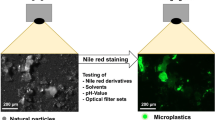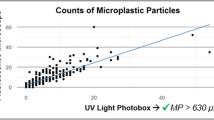Abstract
In the recent years, microplastics have attracted much attention as new emerging environmental pollutants. Previously, several studies were performed to understand the source and fate of microplastics in the environment, organisms, and food webs. To track microplastics and improve their legibility, labeling them is a very effective method during laboratory experiments. This study presents an effective Rhodamine B dye (RhB) staining method for microplastics. The method is crucial for the visual observation of white or transparent plastics by dyeing them in purple or pink, as well as makes the microplastics to fluoresce under common microscope fluorescence filter ranges. Five types of microplastic polymers, namely polyethylene, polypropylene, polystyrene, polyvinyl chloride, and polyurethane were used as the test materials. The efficiencies of ethanol, acetone, and distilled water as possible solvents for dissolving RhB were investigated. Next, the fluorescence stability in various conditions was assessed. The results indicated that ethanol was the most appropriate solvent in dissolving RhB used in staining the microplastics. RhB was fluorescently stable under varying conditions (light and gut fluid) or different solutions (KOH, nitric acid, and saturated NaCl). Additionally, RhB staining exhibited an insignificant effect on the Raman spectra of the microplastics. Our proposed method is simple and robust and helps to visualize the different types of microplastic polymers tested in laboratory experiments, particularly the transparent, white, and small size microplastics.



Similar content being viewed by others
References
Andrady AL (2011) Microplastics in the marine environment. Mar Pollut Bull 62(8):1596–1605
Conley K, Clum A, Deepe J, Lane H, Beckingham B (2019) Wastewater treatment plants as a source of microplastics to an urban estuary: removal efficiencies and loading per capita over one year. Water Res X 3:100030
Foekema EM, De Gruijter C, Mergia MT, van Franeker JA, Murk AJ, Koelmans AA (2013) Plastic in North Sea fish. Environ Sci Technol 47(15):8818–8824
Gao F, Li J, Sun C, Zhang L, Jiang F, Cao W, Zheng L (2019) Study on the capability and characteristics of heavy metals enriched on microplastics in marine environment. Mar Pollut Bull 144:61–67
Hodson ME, Duffus-Hodson CA, Clark A, Prendergast-Miller MT, Thorpe KL (2017) Plastic bag derived-microplastics as a vector for metal exposure in terrestrial invertebrates. Environ. Sci Technol 51(8):4714–4721
Huppertsberg S, Knepper TP (2018) Instrumental analysis of microplastics - benefits and challenges. Anal Bioanal Chem 410(25):6343–6352
Karakolis EG, Nguyen B, You JB, Rochman CM, Sinton D (2019) Fluorescent dyes for visualizing microplastic particles and fibers in laboratory based studies. Environ Sci Technol Lett 6(6):334–340
Kosuth M, Mason SA, Wattenberg EV (2018) Anthropogenic contamination of tap water, beer, and sea salt. PLoS One 13(4):e194970
Li J, Liu H, Paul Chen J (2018a) Microplastics in freshwater systems: A review on occurrence, environmental effects, and methods for microplastics detection. Water Res 137:362–374
Li J, Zhang K, Zhang H (2018b) Adsorption of antibiotics on microplastics. Environ Pollut 237:460–467
Liebezeit G, Liebezeit E (2014) Synthetic particles as contaminants in German beers. Food Addit Contam Part A 31(9):1574–1578
Liu M, Lu S, Song Y, Lei L, Hu J, Lv W, Zhou W, Cao C, Shi H, Yang X, He D (2018) Microplastic and mesoplastic pollution in farmland soils in suburbs of Shanghai, China. Environ Pollut 242:855–862
Pivokonsky M, Cermakova L, Novotna K, Peer P, Cajthaml T, Janda V (2018) Occurrence of microplastics in raw and treated drinking water. Sci Total Environ 643:1644–1651
Prunier J, Maurice L, Perez E, Gigault J, Pierson Wickmann A, Davranche M, Halle AT (2019) Trace metals in polyethylene debris from the North Atlantic subtropical gyre. Environ Pollut 245:371–379
Qu M, Xu K, Li Y, Wong G, Wang D (2018) Using acs-22 mutant Caenorhabditis elegans to detect the toxicity of nanopolystyrene particles. Sci Total Environ 643:119–126
Razanajatovo RM, Ding J, Zhang S, Jiang H, Zou H (2018) Sorption and desorption of selected pharmaceuticals by polyethylene microplastics. Mar Pollut Bull 136:516–523
Rodrigues JP, Duarte AC, Santos-Echeandía J, Rocha-Santos T (2019) Significance of interactions between microplastics and POPs in the marine environment: a critical overview. Trac-Trends Anal Chem 111:252–260
Stolte A, Forster S, Gerdts G, Schubert H (2015) Microplastic concentrations in beach sediments along the German Baltic coast. Mar Pollut Bull 99(1-2):216–229
Tamminga M, Hengstmann E, Fischer EK (2017) Nile red staining as a subsidiary method for microplastic quantification: a comparison of three solvents and factors influencing application reliability. Sdrp J Earth Sci Environ Stud 2(2):1–8
Thompson CR, Olsen Y, Mitchell RP, Davis A, Rowland SJ, John AWG, McGonigle D, Russell AE (2004) Lost at sea: where is all the plastic. Science 304(5672):838
Wright SL, Thompson RC, Galloway TS (2013) The physical impacts of microplastics on marine organisms: a review. Environ Pollut 178:483–492
Xu X, Wang S, Gao F, Li J, Zheng L, Sun C, He C, Wang Z, Qu L (2019) Marine microplastic-associated bacterial community succession in response to geography, exposure time, and plastic type in China’s coastal seawaters. Mar Pollut Bull 145:278–286
Zhao S, Danley M, Ward JE, Li D, Mincer TJ (2017) An approach for extraction, characterization and quantitation of microplastic in natural marine snow using Raman microscopy. Anal Methods-UK 9(9):1470–1478
Availability of data and materials
The datasets used and/or analyzed during the current study are available from the corresponding author on reasonable request.
Funding
This work was supported by the National Natural Science Foundation of China [grant numbers 51608093]; and “the Fundamental Research Funds for the Central Universities” [grant numbers DUT18RC(4)062].
Author information
Authors and Affiliations
Contributions
HT: Conceptualization; Project administration; Writing—original draft; Writing—review and editing. QJ: Investigation; Data curation. XZ: Resources; Validation. XH: Visualization. All authors read and approved the final manuscript.
Corresponding author
Ethics declarations
Competing interests
The authors declare that they have no competing interests.
Consent for publication
Not applicable
Ethics approval and consent to participate
Not applicable
Additional information
Responsible editor: Philippe Garrigues
Publisher’s note
Springer Nature remains neutral with regard to jurisdictional claims in published maps and institutional affiliations.
Rights and permissions
About this article
Cite this article
Tong, H., Jiang, Q., Zhong, X. et al. Rhodamine B dye staining for visualizing microplastics in laboratory-based studies. Environ Sci Pollut Res 28, 4209–4215 (2021). https://doi.org/10.1007/s11356-020-10801-4
Received:
Accepted:
Published:
Issue Date:
DOI: https://doi.org/10.1007/s11356-020-10801-4




